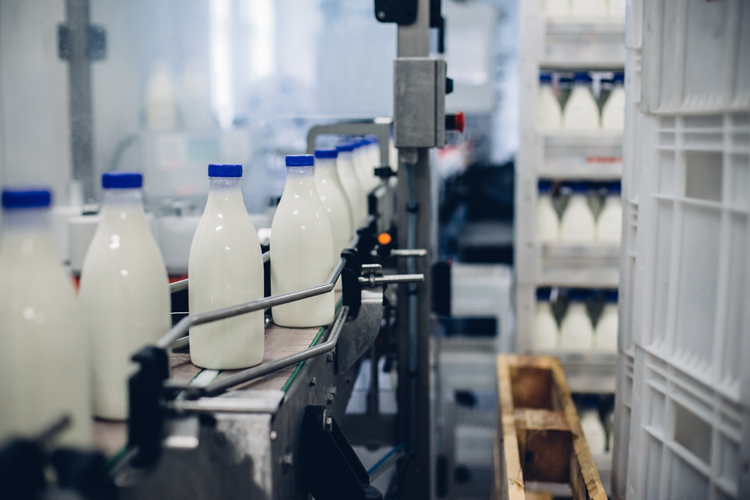NMPF’s Senior Director Theresa Sweeney-Murphy tells Dairy Radio Now listeners about the recent visit to Washington by National Milk’s Young Cooperator representatives, who came to Capitol Hill this week to advocate for the dairy community on key issues like the farm bill and proper dairy foods labeling.
Tag: milk prices
Cheese Exports Boost U.S. Dairy Market
Small Changes in Costs, Prices Move March DMC Margin Above $9.50 Trigger
The DMC margin rose by $0.21/cwt from February to March to $9.65/cwt, putting it just above the maximum $9.50/cwt maximum Tier 1 coverage level. The March All-Milk price rose by $0.10/cwt to $20.70/cwt, and the March DMC feed cost calculation dropped by $0.11/cwt, almost entirely on a $7.00/ton lower premium alfalfa hay price.
The DMC Decision Tool on the USDA/FSA website forecasts that the DMC margin will remain above $9.50/cwt for the rest of 2024. The enrollment period for the 2024 Dairy Margin Program ended on Tuesday. For those who are signed up for 2024 coverage, payments will be made for January’s and February’s triggered payments, depending on coverage level.
U.S. Dairy Exports Rebound as Milk Production Slowly Slips
USDA Decision Time Nears for FMMOs
By Peter Vitaliano, Vice President, Economic Policy & Market Research, NMPF
The April 1 deadline for interested parties to submit post-hearing briefs summing up their arguments for changes to the Federal Milk Marketing Orders (FMMO) has passed. Now that participants in USDA’s record-length FMMO hearing having had their final say, it’s time for USDA to review the complete hearing record and formulate its recommended decision, which should be reported around July 1.
The National Milk Producers Federation offered by far the most comprehensive and constructive set of proposals for effecting long-overdue updates to the federal order pricing formulas. Our brief reemphasized that updating formulas to reflect the dynamically changing structure of the U.S. dairy industry is critically important for the order program to achieve its basic purposes of ensuring an adequate supply of milk for fluid milk use, promoting orderly marketing, and providing adequate prices to dairy farmers for doing so. NMPF’s five specific proposals put farmers first, in keeping with the FMMO mission. They also have very broad support from groups and individuals representing dairy farmer interests.
 By contrast, the major hearing participants representing processors opposed most of the hearing’s 21 proposals, including NMPF’s proposals to raise the Class III and Class IV skim milk component composition factors, remove barrel cheese from the protein component price formula, and update the Class I differentials to reflect current costs of supplying milk for fluid processing. Advocacy by proprietaries focused primarily on just two issues: the particularly high profile matters of the make allowances and the Class I mover.
By contrast, the major hearing participants representing processors opposed most of the hearing’s 21 proposals, including NMPF’s proposals to raise the Class III and Class IV skim milk component composition factors, remove barrel cheese from the protein component price formula, and update the Class I differentials to reflect current costs of supplying milk for fluid processing. Advocacy by proprietaries focused primarily on just two issues: the particularly high profile matters of the make allowances and the Class I mover.
While all parties to the hearing broadly agreed that the make allowances in the orders’ component pricing formulas need to be updated in stages — due largely to how much current costs likely exceed the current make allowances — hearing participants significantly disagreed on specifically how to do so. NMPF and its member cooperatives argued that USDA needs to have the authority and the directive to conduct regular mandatory, audited studies of manufacturing costs and yield factors so the industry, and dairy farmers in particular, can have confidence that the numbers are truly accurate — certainly more accurate than the voluntary cost studies that have more holes than Swiss cheese. All parties support mandatory studies, which almost certainly will be included in the upcoming farm bill. But proprietary manufacturer interests have requested that substantial increases, based only on voluntary studies, be fully implemented with a relatively short phase-in period, a move that would significantly harm dairy farmer incomes.
NMPF and other parties representing dairy farmer interests also universally support returning to the “higher of” Class I mover, a position equally strongly opposed by proprietary processor interests. No one supports the current “average of” mover, with its 74-cent per hundredweight fixed factor, but proprietary interests lined up behind keeping the average of mechanism with an adjustable factor that would mimic, with considerable lags, the higher of mover. This approach, done in the name of improving risk management, unfortunately mutes the immediate market signals the higher of approach sends. It also offers cold comfort to dairies that might go out of business because of a lower mover and don’t have the lag time to wait for a make-up adjustment later.
A low point in the hearing from the standpoint of farmer interests was reached when a group of proprietary fluid processors pushed back against NMPF’s carefully worked out proposal to increase the Class I differentials by proposing instead to eliminate the fixed portion of the current ones, which would effectively erase any difference between Class I and the manufacturing class prices in many orders and render them unworkable. It garnered no support from any other party.
But for all the controversy seen thus far, soon it will all be superseded by USDA’s plan. NMPF remains hopeful that careful thinking and attention to the purpose and mission of federal orders carries the day. We’re confident in a positive outcome.
This column originally appeared in Hoard’s Dairyman Intel on April 15, 2024.
NMPF’s Paul Bleiberg Outlines USDA Decision On WIC Dairy Purchases
NMPF’s Executive Vice President Paul Bleiberg gives Dairy Radio Now the background on this week’s decision by USDA to adjust spending for WIC program recipients, and how that will impact dairy purchases, including milk, as the changes are implemented.
February DMC Margin Gains Nearly $1/cwt Over January
The February margin under the Dairy Margin Coverage (DMC) program rose by $0.96/cwt from a month earlier to $9.44/cwt, triggering a payment of $0.06/cwt for coverage at the $9.50/cwt maximum Tier 1 level.
The rise was due to a $0.50/cwt increase in the February U.S. average all-milk price to $20.60/cwt, and a $0.46/cwt drop in the DMC feed cost formula, mostly as a result of lower corn prices.
Futures-based forecasts at the end of March indicated that DMC margins would remain mostly above the $9.50/cwt maximum Tier 1 coverage level during the remainder of the current calendar year, with possible brief dips below this level in late spring.
Key Dairy Statistics Reveal Continued Production Decline
NMPF’s Bleiberg discusses new congressional report on need for farm labor
NMPF’s Executive Vice President Paul Bleiberg joins Dairy Radio Now this week to assess the impact of a new report from the House Agriculture Committee on the need that dairy farms and other ag employers have for farm workers, and what the prospects are for the push to expand the H2A visa program to dairy employers.
The Class I Mover Needs to Move
 By Paul Bleiberg, Executive Vice President, Government Relations, NMPF
By Paul Bleiberg, Executive Vice President, Government Relations, NMPF
Even as an election looms on the horizon, USDA will soon develop its Federal Milk Marketing Order (FMMO) modernization recommendations after months of proceedings. Meanwhile, Congress is preparing to advance a farm bill. U.S. dairy farmers and their cooperatives have a stake in both. But regardless of the policy landscape of the moment, one pressing priority that unites producers from coast to coast in every way, shape, and form is the need to restore the “higher of” Class I mover.
Since it was implemented five years ago, the current “average of” Class I mover has cost dairy farmers nationwide more than $1 billion in Class I skim revenue, with losses continuing to pile up monthly. This, of course, was not intended — but neither were the repeated price inversions that upended decades of data and showed the new mover is poorly adapted to dairy’s present and future in a variety of economic climates.
Congress changed the mover during the last farm bill to respond to fluid processor requests for risk management, but that was with the expectation that it would be revenue neutral for the dairy producer. Unfortunately, the new mover has been anything but revenue neutral, and it’s been so in a way that has overwhelmingly favored processors, who are not the epicenter of the FMMO system. The new mover has underperformed repeatedly, to the detriment of dairy farmers, in 2020, 2022, 2023, and again, month by month, in 2024. The current formulation has harmed farmers so consistently that it would have been nowhere close to revenue neutral even setting aside the calamity of 2020.
In an attempt to remedy an intolerable situation (everyone, even processors, agrees on that point, at least), several concepts have been put forth that are bandages to the problem but aren’t true solutions. Modifying the current formula, for example, to retroactively recoup producer losses would still fail to send timely price signals to farmers. The argument that this modified version would have paid more to farmers at some point just yet again exposes the problem with the “average of,” which is that it causes farmers to suffer losses when they should have been paid based on market signals and instead distorts the true market by paying them back later. That approach also provides little help to the many family dairy producers who don’t have years to be made whole, a fact underscored forcefully by continued trends toward farm consolidation.
The solution to this problem comes down to priorities. The current mover may have been a fair experiment to test, but with its performance now having been assessed, continuing the “average of” formulation can be to nothing except the detriment of dairy farmers who have lost more than $1 billion dollars of ongoing disorderly marketing of milk.
The right solution is the previous “higher of” mover. That tried-and-true approach, one that served farmers well for decades, responds quickly to and accurately reflects the marketplace, encouraging the orderly marketing of milk that provides the rationale for the FMMO system, and it helps dairy farmer cash flow when it counts. The “higher of” Class I mover must be reinstated.
This column originally appeared in Hoard’s Dairyman Intel on March 4, 2024.
NMPF’s Galen Urges DMC Signup
NMPF Senior Vice President Chris Galen detailed improvements to the Dairy Margin Coverage program in an interview with the National Association of Farm Broadcasters. “We encourage people to look at the dairy margin coverage program if they’re not already covered or to make adjustments in their coverage levels, because you don’t know what’s going to happen with either milk prices or feed costs,” he said.






